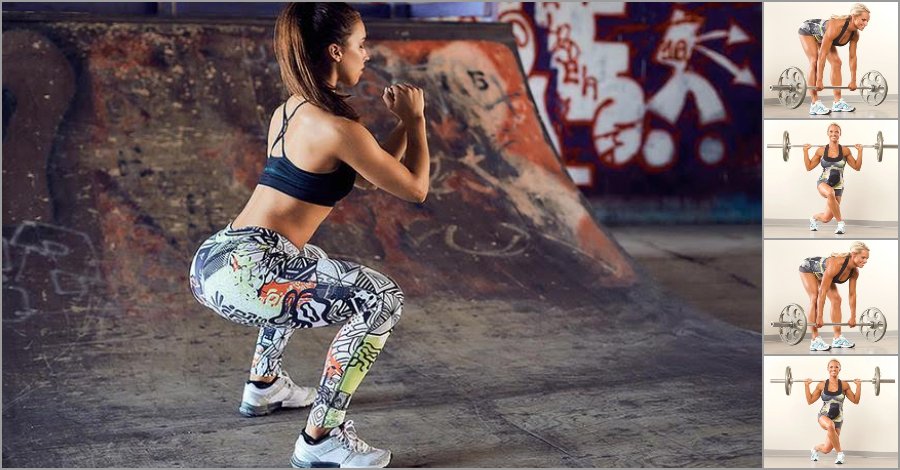Most women count their repetitions at a constant, steady pace. But to spark a change in your body’s composition, you need to shock your muscles with new training methods. That’s where these series of numbers come in: they each represent time in seconds and provide a “tempo map” for your reps.
Take the series 1–2–1 in relation to a leg press: one second to press the weight, a two-second hold at the midway point as you lower, and one second to return to the start. And by changing the speed of your reps during each set, you’ll challenge even more fibers while honing in on different areas of your muscles.
When muscles ‘get into a groove’ due to constant repetition, speed and load, they stop adapting. But by mixing different tempos with varying ranges of motion, you will boost muscular fatigue – a critical factor in building show-stopping glutes.
Each exercise set will be done at a unique tempo, as reflected at right. Perform these up to three times per week on nonconsecutive days, and your glutes will be tighter before autumn is through.
Range Of Motion 411:

Before delving into this plan, familiarize yourself with your muscles’ contraction phases. There are three basic phases that a muscle goes through during each repetition’s range of motion (ROM):
- Concentric Phase: This is the shortening phase of a muscular contraction. This can be easily understood by envisioning how your working muscle looks during the “pump” sensation (short and round).
- Isometric Phase: Defined as the state of holding a muscle in one place during a contraction – it doesn’t get any shorter or longer. This contraction is also known as the loading phase.
- Eccentric Phase: This is the lengthening phase, which generally occurs when you are lowering a weight back to the starting position.
Your tempo schemes are coded as follows. Carefully read the exercise descriptions to find out at what point in the exercise each phase occurs.
1•2•1
- one second
- two seconds
- one second
- Concentric
- Isometric
- Eccentric
45-Degree Leg Press:

How to:
- Sit on the loaded machine and place your feet on the footplate, hip-width apart.
- Push the footplate until your legs are straight but not locked (concentric contraction).
- Bend your knees partially and pause (isometric), then lower back to the start (eccentric).
- Be sure to lower your knees as close to your chest as you can before pushing the footplate upward.
Stability-Ball Hamstring Curl:

How to:
- Lie faceup on a mat, with heels firmly planted on a stability ball and arms at your sides as shown.
- Lift your hips toward the ceiling until your body forms a straight line.
- Keeping your hips lifted, bend your knees to pull the ball towards your glutes (concentric contraction).
- Pause at the top (isometric), then straighten your legs and return the ball to the starting position (eccentric).
- Intensify this exercise by pointing one leg toward the ceiling and curling with only one leg.
Stiff-Legged Barbell Deadlift:

How to:
- Grasp a barbell with a shoulder-width overhand grip.
- Bend forward from your hips to lower the bar to mid-shin level as shown.
- Extend from your hips to stand (concentric contraction).
- Slowly lower the bar back towards the ground, pausing halfway (isometric).
- Then continue lowering (eccentric) until your body and the bar are back at the starting position.
- Throughout the range of motion, keep the bar close to your thighs to protect your lower back.
Barbell Curtsy Squat:

How to:
- Place a bar across your upper back and hold it with a shoulder-width or wider grip, palms facing forward.
- Step your left foot behind and to the outside of your right leg and bend both knees to lower your body as shown.
- Straighten your legs to stand (concentric contraction).
- Bend your knees again, but stop halfway and hold (isometric).
- Continue until you reach the start (eccentric).
- Once your set is through, switch legs and repeat.
- A lifted chest will help you maintain your balance as you rise and lower.
One-Legged Plate Drag:

How to:
- Lie faceup on a mat, with your left leg bent and right leg extended.
- Place your right heel inside the hole of a weight plate and lift your hips from the ground.
- Bend your right knee to drag the plate towards you (concentric contraction), pause (isometric), then return to the start (eccentric).
- When your set is done, repeat on your left leg.
- Reach your arms overhead and grasp a secure track or machine behind you to aid stability.

